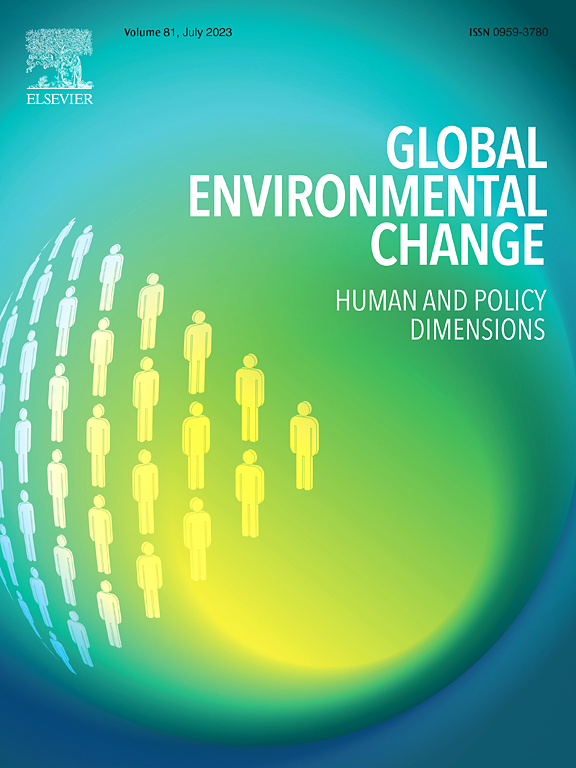Integrating climate mitigation and adaptation in the UK: A new anticipatory narrative for achieving “Climate Resilient Net Zero” in preparing for heat risk
IF 9.1
1区 环境科学与生态学
Q1 ENVIRONMENTAL SCIENCES
引用次数: 0
Abstract
Climate Policy Integration (CPI) is key to mainstreaming and harmonising mitigation and adaptation in policy responses to climate change worldwide. However, little is known about how CPI can be applied in practice, beyond single policy areas, particularly in the integration of adaptation and mitigation responses. We investigate this in the context of responding to climate impacts such as extreme heat, a climate risk growing in international importance. Using the 2022 UK heatwaves as a case study, our paper explores: (a) the extent to which key stakeholders consider the integration of adaptation and mitigation to be important; (b) perceptions of the feasibility of integration; and (c) main enablers and/or challenges with integration of adaptation and mitigation. To do this, interviews (N = 38) and four focus groups (N = 21) were conducted with policymakers, first responders, utility providers, and civil society responsible for managing heat risks. Our findings reveal a tension that CPI is essential to achieving a “climate resilient net zero”, yet unrealised. To facilitate CPI, we present a new anticipatory narrative with international and multi-contextual significance, that considers the convergence of key elements integral to effective CPI decision-making in the context of heat risk: (1) ‘Challenges’ − that may hinder, undermine, or act as a barrier to the integration of mitigation and adaptation; (2) ‘Enablers’ − which support, or help to facilitate greater integration, or synergies, between mitigation and adaptation; (3) ‘Framings’ − different ways participants described, defined or interpreted the issue of integration; (4) ‘Importance’ – the extent to which participants thought that integrating mitigation and adaptation was important; and (5) ‘Feasibility’ – or how possible integration is. We conclude that unless all five elements are fully addressed iteratively by end-users when tackling and understanding heat risks, new problems may emerge.
整合英国的气候减缓和适应措施:实现 "具有气候复原力的净零 "以应对热风险的新预测论述
气候政策一体化是将减缓和适应纳入全球应对气候变化政策主流并使之协调一致的关键。然而,除了单一政策领域之外,人们对CPI如何在实践中应用知之甚少,特别是在适应和缓解对策的整合方面。我们在应对极端高温等气候影响的背景下对此进行了调查,极端高温是一种日益重要的国际气候风险。以2022年英国热浪为例,我们的论文探讨了:(a)主要利益相关者认为适应和减缓一体化的重要性;(b)对一体化可行性的看法;(c)适应和缓解一体化的主要推动因素和/或挑战。为此,对负责管理热风险的政策制定者、急救人员、公用事业供应商和民间社会进行了访谈(N = 38)和四个焦点小组(N = 21)。我们的研究结果揭示了一种矛盾,即CPI对于实现“气候弹性净零”至关重要,但尚未实现。为了促进CPI,我们提出了一种具有国际和多背景意义的新的预期叙述,该叙述考虑了在热风险背景下有效CPI决策所必需的关键要素的趋同:(1)“挑战”-可能阻碍、破坏或成为减缓和适应一体化的障碍;(2) “促进因素” -支持或帮助促进缓解和适应之间更大程度的融合或协同作用;(3)“框架”——参与者描述、定义或解释整合问题的不同方式;(4) “重要性”——与会者认为将缓解和适应结合起来的重要程度;(5)“可行性”——即整合的可能性有多大。我们得出的结论是,除非最终用户在处理和理解热风险时完全迭代地解决这五个要素,否则可能会出现新的问题。
本文章由计算机程序翻译,如有差异,请以英文原文为准。
求助全文
约1分钟内获得全文
求助全文
来源期刊

Global Environmental Change
环境科学-环境科学
CiteScore
18.20
自引率
2.20%
发文量
146
审稿时长
12 months
期刊介绍:
Global Environmental Change is a prestigious international journal that publishes articles of high quality, both theoretically and empirically rigorous. The journal aims to contribute to the understanding of global environmental change from the perspectives of human and policy dimensions. Specifically, it considers global environmental change as the result of processes occurring at the local level, but with wide-ranging impacts on various spatial, temporal, and socio-political scales.
In terms of content, the journal seeks articles with a strong social science component. This includes research that examines the societal drivers and consequences of environmental change, as well as social and policy processes that aim to address these challenges. While the journal covers a broad range of topics, including biodiversity and ecosystem services, climate, coasts, food systems, land use and land cover, oceans, urban areas, and water resources, it also welcomes contributions that investigate the drivers, consequences, and management of other areas affected by environmental change.
Overall, Global Environmental Change encourages research that deepens our understanding of the complex interactions between human activities and the environment, with the goal of informing policy and decision-making.
 求助内容:
求助内容: 应助结果提醒方式:
应助结果提醒方式:


